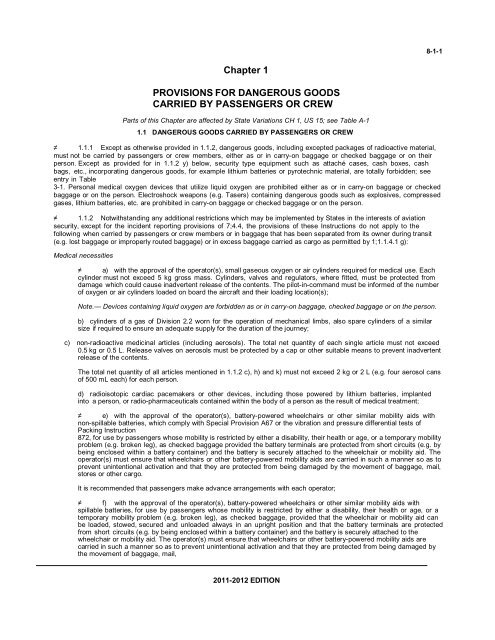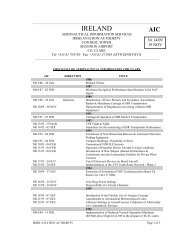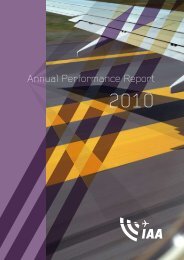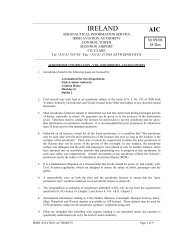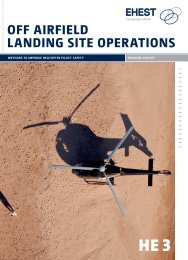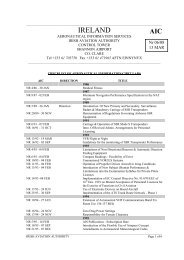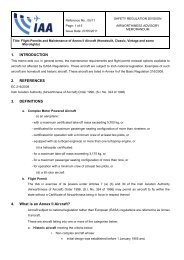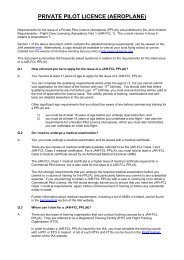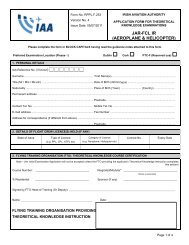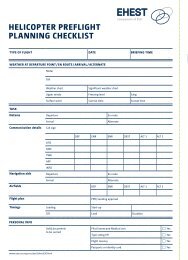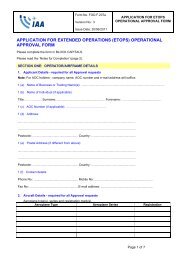Chapter 1 PROVISIONS FOR DANGEROUS GOODS CARRIED BY ...
Chapter 1 PROVISIONS FOR DANGEROUS GOODS CARRIED BY ...
Chapter 1 PROVISIONS FOR DANGEROUS GOODS CARRIED BY ...
- No tags were found...
You also want an ePaper? Increase the reach of your titles
YUMPU automatically turns print PDFs into web optimized ePapers that Google loves.
8-1-2 Part 8stores or other cargo. If the wheelchair or mobility aid cannot be loaded, stowed, secured and unloaded always in anupright position, the battery must be removed and the wheelchair or mobility aid may then be carried as checkedbaggage without restriction. The removed battery must be carried in strong, rigid packagings as follows:1) these packagings must be leak-tight, impervious to battery fluid and be protected against upset by securingthem to pallets or by securing them in cargo compartments using appropriate means of securement (otherthan by bracing with freight or baggage) such as by the use of restraining straps, brackets or holders;2) batteries must be protected against short circuits, secured upright in these packagings andsurrounded by compatible absorbent material sufficient to absorb their total liquid contents; and3) these packagings must be marked “Battery, wet, with wheelchair” or “Battery, wet, with mobility aid”and be labelled with a “Corrosive” label (Figure 5-22) and with a package orientation label (Figure 5-26).The pilot-in-command must be informed of the location of a wheelchair or mobility aid with an installed battery orthe location of a packed battery.It is recommended that passengers make advance arrangements with each operator; also, unless batteries arenon-spillable they should be fitted, where feasible, with spill-resistant vent caps;+ g) with the approval of the operator(s), lithium-ion battery-powered wheelchairs or other similar mobility aidsfor use by passengers whose mobility is restricted by either a disability, their health or age, or a temporary mobilityproblem (e.g. broken leg), subject to the following conditions:1) the batteries must be of a type which meets the requirements of each test in the UN Manual of Tests andCriteria, Part III, section 38.3;2) battery terminals must be protected from short circuits (e.g. by being enclosed within a battery container)and securely attached to the mobility aid;3) the operator(s) must ensure that such mobility aids are carried in a manner so as to preventunintentional activation and that they are protected from being damaged by the movement of baggage, mail,stores or other cargo; and4) the pilot-in-command must be informed of the location of the mobility aid.It is recommended that passengers make advance arrangements with each operator.+ h) with the approval of the operator(s), portable medical electronic devices (Automated ExternalDefibrilators (AED), Nebulizer, Continuous Positive Airway Pressure (CPAP), etc.) containing lithium metal or lithiumion cells or batteries carried by passengers for medical use. No more than two spare batteries may be carried.Spare batteries must be individually protected so as to prevent short circuits (by placement in original retail packagingor by otherwise insulating terminals, e.g. by taping over exposed terminals or placing each battery in a separate plasticbag or protective pouch) and carried in carry-on baggage only. Each installed or spare battery must be of a type whichmeets the requirements of each test in the UN Manual of Tests and Criteria, Part III, section 38.3;In addition, each installed or spare battery must not exceed the following:— for lithium metal batteries, a lithium content of not more than 8 grams; or— for lithium ion batteries, a watt-hour rating of not more than 160 Wh.i) one small medical or clinical thermometer which contains mercury, for personal use, when in its protective case;Articles used in dressing or groomingj) toiletry articles (including aerosols). The total net quantity of each single article must not exceed 0.5 kg or 0.5 L.Release valves on aerosols must be protected by a cap or other suitable means to prevent inadvertent release of thecontents. The term “toiletry articles (including aerosols)” is intended to include such items as hair sprays, perfumes andcolognes.The total net quantity of all articles mentioned in 1.1.2 c), h) and k) must not exceed 2 kg or 2 L (e.g. four aerosol cansof 500 mL each) for each person.k) hair curlers containing hydrocarbon gas, no more than one per person, provided that the safety cover is securelyfitted over the heating element. Gas refills for such curlers must not be carried;Consumer articlesl) when in retail packagings, alcoholic beverages containing more than 24 per cent but not more than 70 per centalcohol by volume, in receptacles not exceeding 5 L, with a total net quantity per person of 5 L for such beverages.2011-2012 EDITION
<strong>Chapter</strong> 1 8-1-3Note.— Alcoholic beverages containing not more than 24 per cent alcohol by volume are not subject to any restrictions.m) Aerosols in Division 2.2, with no subsidiary risk, for sporting or home use is permitted in checked baggage only.The total net quantity of each single article must not exceed 0.5 kg or 0.5 L. Release valves on aerosols must beprotected by a cap or other suitable means to prevent inadvertent release of the contents.The total net quantity of all articles mentioned in 1.1.2 c), h) and k) must not exceed 2 kg or 2 L (e.g. four aerosol cansof 500 mL each) for each person.n) with the approval of the operator(s), as checked baggage only, securely packaged cartridges (UN 0012 or UN0014 only), in Division 1.4S, in quantities not exceeding 5 kg gross mass per person for that person’s own use,excluding ammunition with explosive or incendiary projectiles. Allowances for more than one person must not becombined into one or more packages;o) one small packet of safety matches or a cigarette lighter that does not contain unabsorbed liquid fuel (otherthan liquefied gas), intended for use by an individual when carried on the person. Matches and lighters are notpermitted in checked or carry-on baggage. Lighter fuel and lighter refills are not permitted on one’s person, in carry-onor checked baggage;Note.— “Strike anywhere” matches are forbidden for air transport.p) with the approval of the operator(s), battery-powered equipment capable of generating extreme heat, whichcould cause a fire if activated (e.g. underwater high intensity lamps) providing that the heat producing componentor the battery is packed separately so as to prevent activation during transport. Any battery which has been removedmust be protected against short circuit;q) with the approval of the operator(s), one avalanche rescue backpack per person equipped with a pyrotechnictrigger mechanism containing not more than 200 mg net of Division 1.4S and a cylinder of compressed gas of Division2.2 not exceeding 250 mL. The backpack must be packed in such a manner that it cannot be accidentallyactivated. The airbags within the backpack must be fitted with pressure relief valves;r) with the approval of the operator(s), no more than two small cylinders of carbon dioxide or another suitablegas in Division 2.2, per person, fitted into a self-inflating life-jacket for inflation purposes, plus no more than twospare cartridges;≠ s) portable electronic devices (watches, calculating machines, cameras, cellular phones, laptop computers,camcorders, etc.) containing lithium or lithium ion cells or batteries when carried by passengers or crew forpersonal use, which should be carried as carry-on baggage. Spare batteries must be individually protected so as toprevent short circuits (by placement in original retail packaging or by otherwise insulating terminals, e.g. by tapingover exposed terminals or placing each battery in a separate plastic bag or protective pouch) and carried in carry-onbaggage only. In addition, each installed or spare battery must not exceed the following:— for lithium metal batteries, a lithium content of not more than 2 grams; or— for lithium ion batteries, a watt-hour rating of not more than 100 Wh.With the approval of the operator, lithium ion batteries exceeding a watt-hour rating of 100 Wh but not exceeding160 Wh may be carried as spare batteries in carry-on baggage or in equipment in either checked or carry-on baggage.No more than two individually protected spare batteries per person may be carried.≠ t) fuel cells used to power portable electronic devices (for example cameras, cellular phones, laptopcomputers and camcorders) and spare fuel cell cartridges, under the following conditions:1) fuel cells and fuel cell cartridges may only contain flammable liquids, corrosive substances, liquefiedflammable gas, water reactive substances or hydrogen in metal hydride;2) refuelling of fuel cells on board an aircraft is not permitted except that the installation of a spare cartridge is allowed;3) the maximum quantity of fuel in any fuel cell or fuel cell cartridge must not exceed:a) for liquids 200 mL;b) for solids 200 grams;c) for liquefied gases, 120 mL for non-metallic fuel cells or fuel cell cartridges or 200 mL for metal fuelcells or fuel cell cartridges;For hydrogen in metal hydride, the fuel cell cartridges must have a water capacity of 120 mL or less;4) each fuel cell and each fuel cell cartridge must conform to IEC PAS 62282-6-1 Ed. 1, and must be markedwith a manufacturer’s certification that it conforms to the specification. In addition, each fuel cell cartridge must bemarked with the maximum quantity and type of fuel in the cartridge;2011-2012 EDITION
8-1-4 Part 85) fuel cell cartridges containing hydrogen in metal hydride must comply with the requirements in SpecialProvision A162.6) no more than two spare fuel cell cartridges may be carried by a passenger, as follows:a) fuel cell cartridges containing flammable liquids, corrosive substances, liquefied flammable gas orhydrogen in metal hydride in carry-on baggage, in checked baggage or on the person; andb) fuel cell cartridges containing water-reactive substances in carry-on baggage or on the person;7) fuel cells containing fuel are permitted in carry-on baggage only;8) interaction between fuel cells and integrated batteries in a device must conform to IEC PAS 62282-6-1 Ed. 1.Fuel cells whose sole function is to charge a battery in the device are not permitted;9) fuel cells must be of a type that will not charge batteries when the portable electronic device is not in use andmust be durably marked by the manufacturer: “APPROVED <strong>FOR</strong> CARRIAGE IN AIRCRAFT CABIN ONLY”to so indicate; and10) in addition to the languages which may be required by the State of Origin for the markings specified above,English should be used.u) with the approval of the operator, dry ice in quantities not exceeding 2.5 kg per person, when used to packperishables that are not subject to these Instructions, provided the package permits the release of carbon dioxide gas.When carried in checked baggage, each package must be marked:— “DRY ICE” or “CARBON DIOXIDE, SOLID”; and— with the net weight of dry ice or an indication that the net weight is 2.5 kg or less;v) with the approval of the operator(s), as carry-on baggage only, a mercurial barometer or mercurial thermometercarried by a representative of a government weather bureau or similar official agency. The barometer or thermometermust be packed in a strong outer packaging, having a sealed inner liner or a bag of strong leakproof and punctureresistantmaterial impervious to mercury, which will prevent the escape of mercury from the package irrespective of itsposition. The pilot- in-command must be informed of the barometer or thermometer;w) with the approval of the operator(s), as carry-on or checked baggage, instruments containing radioactive materialnot exceeding the activity limits specified in Table 2-15 (i.e. chemical agent monitor (CAM) and/or rapid alarmand identification device monitor (RAID-M)), securely packed and without lithium batteries, when carried by staffmembers of the Organization for the Prohibition of Chemical Weapons (OPCW) on official travel;+ x) energy efficient light bulbs when in retail packaging intended for personal or home use.+ Security-type equipmenty) With the approval of the operator(s), security type equipment such as attaché cases, cash boxes, cash bags,etc. incorporating dangerous goods as part of this equipment, for example lithium batteries or pyrotechnic material,may be carried as checked baggage only if the equipment complies with the following:1) the equipment must be equipped with an effective means of preventing accidental activation;2) if the equipment contains an explosive or pyrotechnic substance or an explosive article, this article orsubstance must be excluded from Class 1 by the appropriate national authority of the State of Manufacture incompliance with Part 2;1.5.2.1;3) if the equipment contains lithium cells or batteries, these cells or batteries must comply with thefollowing restrictions:a) for a lithium metal cell, the lithium content is not more than 1 g;b) for a lithium metal or [lithium alloy] battery, the aggregate lithium content is not more than 2 g;c) for lithium ion cells, the Watt-hour rating (see Attachment 2) is not more than 20 Wh;d) for lithium ion batteries, the Watt-hour rating is not more than 100 Wh;e) each cell or battery is of the type proven to meet the requirements of each test in the UN Manual of Tests andCriteria, Part III, section 38.3;2011-2012 EDITION
<strong>Chapter</strong> 1 8-1-54) if the equipment contains gases to expel dye or ink, only gas cartridges and receptacles, small, containing gaswith a capacity not exceeding 50 mL, containing no constituents subject to these Instructions other than a Division2.2 gas, are allowed. The release of gas must not cause extreme annoyance or discomfort to crew members soas to prevent the correct performance of assigned duties. In case of accidental activation, all hazardous effectsmust be confined within the equipment and must not produce extreme noise.5) security type equipment that is defective or that has been damaged is forbidden for transport.1.1.3 Any organization or enterprise other than an operator (such as a travel agent), involved in the air transport ofpassengers, should provide passengers with information about the types of dangerous goods which they are forbidden totransport aboard an aircraft. This information should consist of, as a minimum, notices at those locations where there is aninterface with the passengers.+ 1.1.4 Where provision is made for the purchase of tickets via the Internet, information on the types of dangerousgoods which a passenger is forbidden to transport aboard an aircraft should be provided in either text or pictorial form andshould be such that ticket purchase cannot be completed until the passenger, or a person acting on their behalf, hasindicated that they have understood the restrictions on dangerous goods in baggage.2011-2012 EDITION


